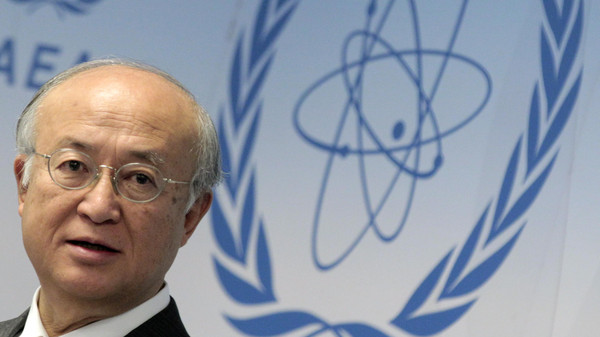PHOTO: IAEA head Yukiya Amano
LATEST
The International Atomic Energy Agency has closed its file on Iran’s past nuclear activities, clearing another hurdle for implementation of Tehran’s July 14 nuclear deal with the 5+1 Powers.
The IAEA report said that, while Iran may have pursued activities before 2009 that could have contributed to a militarized nuclear program, it had not done so since then.
The report also said it found no evidence that Iran tried to procure materials illegally for nuclear weapons after 2007.
The Agency specifically declared that it had “not found indications of an undeclared nuclear fuel cycle…beyond those activities declared retrospectively” of of “nuclear components for an explosive device”. It assesses that “Iran conducted computer modelling of a nuclear explosive device prior to 2004 and between 2005 and 2009”, but “these activities did not advance beyond feasibility and scientific studies, and the acquisition of certain relevant technical competences and capabilities”.
The IAEA firmly concluded, “The Agency has no credible indications of activities in Iran relevant to the
development of a nuclear explosive device after 2009.”
Iran’s Deputy Foreign Minister Abbas Araqchi responded that the 5+1 Powers (US, Britain, France, Germany, China, and Russia) should now “close the issue at the [IAEA] Board of Governors”.
The US State Department was positive about the outcome. “The IAEA has confirmed that Iran met its commitments to provide responses to IAEA requests under the road map for clarification of past and present issues,” spokesman Mark Toner said.
Toner explained that the 5+1 Powers would submit a resolution “with a view toward closing the PMD issue. And then, after that, we can focus on implementing the JCPOA [Joint Comprehensive Plan of Action].”
Iran’s Rouhani Government had hoped for full IAEA verification by December 15 of compliance with the JCPOA, allowing for the removal of US and European sanctions which have crippled the Iranian economy.
That timetable has slipped because of objections by Iranian hardliners to implementation, notably the reduction of Tehran’s uranium centrifuges from about 19,000 to just over 5,000, with another 1,000 for research and development. Last week, Deputy Foreign Minister Araqchi said verification was likely in “early January”.
Supreme Leader’s Top Aide: Syria’s Assad Will Be Able to Stand in Elections
The Supreme Leader’s top aide has said that Syria’s President Assad will be able to stand in elections under any international agreement for a political transition.
Ali Akbar Velayati told Lebanon’s al-Mayadeen TV on Wednesday:
President Assad’s government has been formed on the basis of legislative elections and the legal term of this government should end and then presidential elections will be held on their due date and President Assad will participate in these elections….
Day-by-day President Bashar al Assad’s popularity in Syria grows and we are certain that the people of Syria will vote for him once again.
A statement from the second round of international talks in Vienna set out an 18-month transitional period which included elections after ceasefires and a new Constitution, but it did not mention Assad’s future.
Russia, Assad’s other main ally alongside Iran, has also pressed for elections, but Moscow has not said that Assad’s personal participation should be guaranteed.
Velayati, a former Foreign Minister, also declared that “the joint Iran-Syria-Russia-Lebanese Hezbollah partnership will lead to the Syrian government’s victory” with the Syrian military, supported by Russian airstrikes and including Iranian-led units and Hezbollah fighters, regaining control throughout the country “very soon”.
He ruled out any involvement of rebel groups in a political settlement:
The terrorists that took up arms against the Syrian nation do not have the right to negotiate with the Syrian government. Only opposition groups that did not take up arms against the Syrian people can negotiate with the government of Syria.

